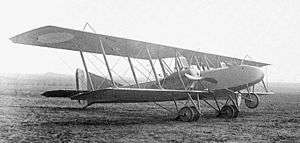Letord Let.7
| Let.7 | |
|---|---|
 | |
| Role | Reconnaissance aircraft |
| National origin | France |
| Manufacturer | Letord of Meudon |
| Designer | Emile Dorand, Emile Louis Letord |
| First flight | 1917-1918 |
| Primary user | Aéronautique Militaire |
_Let7_Airplane.jpg)
The Letord (sometimes written as Letort) Let.7 was a military aircraft produced in France during the First World War, as a long-range reconnaissance aircraft, bomber and bomber escort. They were biplanes of unequal span with prominent and characteristic negative stagger on their wings. They were powered by twin engines mounted on short struts on the lower wing in tractor configuration, and had fixed tailskid undercarriage. Many of the subtypes were also equipped with a nosewheel to protect the aircraft and its crew from "nosing over" accidents while landing. The pilot sat in an open cockpit, with tail gunner in an open position amidships, and a third crewmember in an open position in the nose where he could act as gunner, observer, and bomb-aimer.
Variants
- Let.1 - initial reconnaissance version with Hispano-Suiza 8A engines
- Let.2 - similar to Let.1, with Hispano-Suiza 8Ba engines
- Let.3 - bomber version with Hispano-Suiza 8Ba engines
- Let.4 - reconnaissance version with Lorraine-Dietrich 8A engines
- Let.5 - bomber version with Lorraine-Dietrich 8B engines
- Let.6 - (military designation CA.3) escort fighter with 37 mm cannon and Hispano-Suiza 8Be engines
- Let.7 - bomber version with Lorraine-Dietrich 8B engines
Operators
Specifications
General characteristics
- Crew: 3
- Length: 11.06 m (36 ft 3 in)
- Wingspan: 18.05 m (59 ft 3 in)
- Height: 3.70 m (12 ft 2 in)
- Wing area: 62.3 m2 (671 sq ft)
- Empty weight: 1,660 kg (3,660 lb)
- Gross weight: 2,450 kg (5,401 lb)
- Powerplant: 2 × Lorraine-Dietrich 8B , 180 kW (240 hp) each
- Propellers: 2-bladed
Performance
- Maximum speed: 156 km/h (97 mph; 84 kn)
- Service ceiling: 4,870 m (15,980 ft)
Armament
- Guns: 3
- Bombs: ?
See also
Related lists